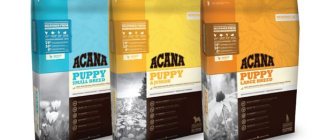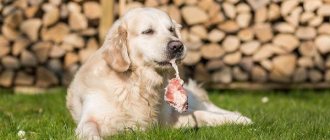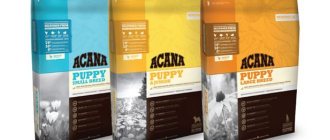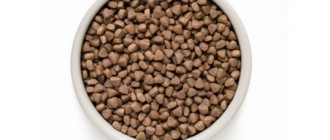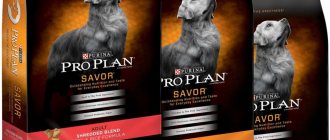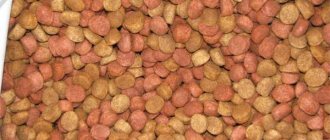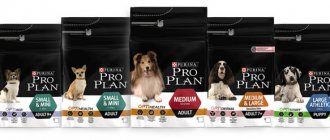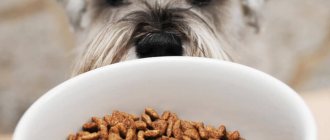10/31/201810/31/2018 Ivan Korabelnikov 0 comments
A small four-legged miracle has appeared in your home and threatens to grow into a loyal friend and protector. What should I feed him? Meat and porridge or immediately switch to dog food, which is sold in abundance in any pet store? It’s just not clear how to choose - there are so many varieties that it’s dizzying. And the prices vary by an order of magnitude.
For an amateur, this is a really difficult question, so let’s listen to the opinions of veterinarians and experienced dog breeders, and at the same time understand the features of dry food.
Dog food is the best alternative to homemade food
We are always accustomed to consider four-legged friends as family members, completely forgetting that by nature they are predators. This means that without meat, offal and bones they simply will not survive.
Many people feed their pets porridge with water and table scraps, occasionally diluting them with meat broths and a handful of bones. But do not forget that dogs are not herbivores or rodents, who do not need anything other than plant food. Try feeding a goat or a cow meat and sausage - it’s absurd, isn’t it? What is it like for a poor animal to chew food that is absolutely not suitable for it?
Yes, of course, any dog needs cereals, as well as vegetables and fruits for a full life, but their quantity is very limited.
The best dog food is raw animal products, which are the ones that are best absorbed by the body. True, the owners noted that exclusively raw food contributes to the appearance of a specific odor, so feeding half-cooked meat is allowed.
Any animal can be content with the same food for a long time, as long as it meets its needs. It may seem to you that your pet lacks variety and you, like a real chef, will start cooking something new every time. Believe me, this is unnecessary! This will only spoil your four-legged friend. You shouldn’t make him a gourmet or a picky eater.
A dog's daily diet should consist of two-thirds meat products and one-third plant foods.
It is mandatory to give tripe - lungs, heart, stomach, udder, kidneys. And pamper your pet with sugar bones more often; they need them vitally to strengthen their teeth and gums. But keep in mind, bones are in no way food.
Dog food types
Conventionally, all types of dog nutrition can be divided into three groups: 1. natural food (“natural”), 2. mixed nutrition and 3. dry food (“drying”).
In the canine world, “straight” and “drying” have their adherents and opponents. I do not speak categorically on this issue. The only thing I categorically do not accept is feeding the dog “from the table”. A dog is not a pig, so table scraps, soups, porridge and pasta, in my opinion, are absolutely not suitable for feeding dogs!
Are you feeding your pet correctly?
How correctly you feed your dog and the quality of the food can always be determined by its waste products.
- Brown, soft, sausage-shaped stool means your pet is getting everything it needs from its diet.
- Solid waste that is white or light yellow in color indicates that you are overusing bones.
- Black - too much meat.
- Mushy - your dog is not eating enough nourishing and nutritious food.
Under no circumstances should you feed an animal from your table - this is unreasonable and will not lead to anything good. After all, the body of a dog and a person are not the same, which means their needs are different.
Of course, a dog will never refuse a tasty piece, be it sausage or candy, but why deliberately harm digestion, which is not designed to digest human food?
How to choose the right lump for your dog
Inexperienced owners often do not know how to choose the right dog for their dog. Relying on intuition, the owner falls for the marketer’s “hook” and begins to feed the dog the most popular, but low-quality food.
The quality of the feed should always be at the forefront. Remember that it is better to feed your dog natural food than cheap food of questionable quality.
Moreover, a natural diet is cheaper in terms of feed. However, ready-made food has an undeniable advantage - it does not need to be prepared, and this saves a lot of time.
Pros and cons of dry food
What then should we feed our four-legged family member if our food does not suit him? There are two options - prepare natural food for your dog every day, carefully maintaining all proportions and observing dietary habits, or make your life easier by choosing dry food.
The advantages of dry food are as follows.
- Simple, affordable and no cooking required.
- It is easy to determine the daily norm based on your pet's weight.
- There is no need for additional vitamins, since the diet is balanced.
- The variety of products allows you to choose the optimal diet based on the needs of the animal, its age and the presence of diseases.
- Cheaper than natural products.
- Convenient for trips and travel.
There are also disadvantages.
- Who knows what these foods are actually made from.
- May cause allergies.
- Economy-class products often replace meat with soy and low-quality offal, which has a detrimental effect on the body.
- Manufacturing technology involves the use of high temperatures, which can destroy vitamins and minerals.
- All dry food contains preservatives and emulsifiers, which means they can cause an allergic reaction or lead to illness.
Now you are faced with a dilemma - to prepare healthy dog dishes every day from carefully selected products or choose industrial food, it is unknown what it was prepared from, but it makes the life of dog owners much easier.
Ready-made feed mixtures and canned food for animals
Feed rating based on points from 1 to 100 in different categories and prices
From 0 to 10 points . This category of food is not cheap, but in terms of quality and safety for animals it is the worst. The ingredients are waste from the processing of livestock and poultry carcasses, plus the presence of indigestible additives and drugs. For owners, this is the best way to get rid of an unfortunate animal and quite quickly.
In this category:
- “Kiteket” - according to nutrition specialists and veterinarians - 1 point
- "Chappie" - 1
- "Pedigree" - 3
- Whiskas - 3
From 10 to 25 points . “Meat” food in this category contains everything except meat - this justifies the low cost of this product. Most often, the composition is waste from meat processing, giblets, cheap cereals, and bran. People here have never heard of vitamins, although in most cases they are stated on the packaging. Of course, food for animals in this category is not so dangerous for their lives, but they certainly will not improve their health. In the absence of anything better, the animal’s body gets used to this feeding, and with a clear lack of vitamins in their diet, the animals themselves find them or “save” them in their liver.
In this category:
- "Meal" - 13 points
- "Vaska" - 15
- "Max" - 22
From 25 to 50 points . Very economical food of low quality. It contains extremely low-use ingredients, vitamins and protein, and they are poorly balanced. It is suitable for unpretentious animals that do not have genetic health problems. Young animals should be fed this food with extreme caution, and it is better to avoid its use altogether at least until the age of two.
In this category:
- “Gourmet” – 26 points
- Oscar - 38
- "My Lady" - 40
- "My Lord" - 40
- "Friskies" - 43
- "Doctor Clouder" - 45
From 50 to 75 points . This is a category of inexpensive food of satisfactory quality, but poor in vitamins. For the most part, dogs live well on this diet if the intake is increased and additional portions of fortified supplements are given. The financial savings here are quite relative, since you still have to purchase the necessary components. The owner is a master, as they say...
In this category:
- "Purina" - 60 points
- "Sheba" - 67
- “Gurmet” - in different types from 55 to 65
- "Doctor Alders" - from 50 to 70
- "Jimpet" - 72
- "Doctor Alders Nature Coast" - 75
From 75 to 90 points . Category of feed with good performance. If animals accept this food well, then switching to a higher and more expensive category does not make sense. The composition of ingredients is balanced and as close as possible to what is stated on the packaging. Does not require additional vitamin supplements and does not cause allergic reactions.
In this category:
- Royal Canin (Russia) – 77 points
- “Pro Pak” (Ukraine) – 78
- "Diamond" - 79
- "Leonardo" - 80
- "Belkando" - 80
- "Flatazor" - 82
- “Pro Pak” (America) – 85
- "Nutro Gold" - 85
- "Nutro Nuggets" - 85
- Royal Canin (France) - 88
- "Biomil" - 89
- "About Plan" - 89
From 90 to 100 points . The best, highest category of feed. The food is developed using the most modern technologies. It is perfectly balanced, of excellent quality, and contains a maximum of useful components for our little brothers. Despite the high price, this diet is very economical, since a relatively small portion gives the animal everything it needs for a healthy and active life.
In this category:
- "Yams" - 93 points
- Eagle Pack - 95
- "Bosch" - 95
- "Eukanuba" - 99
- "Hills" - 100
- “Nutro Choice” – 100
Types of dog food
Dog food varies in form and purpose.
By release form
- Dry - they are compressed crackers; when consuming them, your pet needs to be given a lot of water.
- Wet are canned food consisting of boiled products, including up to 80% water.
- Semi-moist - made on the basis of propylene glycol, which prevents drying.
By pet's age
Tiny kittens left without a mother can be fed with formula milk from the first day. After two weeks they begin to be given complementary foods.
Puppies from two months of age and young dogs up to two and a half years old should receive the best, selected food. The granules are made small so that they are easy to chew. A growing body requires a lot of protein and vitamins. The more nutritious and healthy the food, the healthier the pet will grow up. Strong bones and powerful muscles are achieved not by the quantity of food, but by its quality.
Adult animals (from 2.5 to 8 years) eat depending on their activity.
- Active – a standard set of ingredients taking into account the daily rhythm of life.
- Highly active - nutrition is enriched with elements that provide additional energy, as well as vitamin E, amino acids and proteins.
- Sedentary people and those prone to obesity – caloric intake is reduced, a lighter diet is offered.
Elderly four-legged animals (from 8 years old) should eat easily digestible food that will not unduly burden the internal organs. The food consists of 18% protein, 12% fat and a high amount of carbohydrates.
By breed size
The smaller the breed, the faster the metabolism. Soy, corn, and barley are strictly not recommended for such dogs, since they only load the stomach, increase the volume of food, but do not provide any benefit at all. The dog will not eat much, which means that the food should contain as many useful substances as possible.
Medium breeds are characterized by mobility. The main thing in their diet is to achieve a balance of proteins, fats and carbohydrates. It must contain vitamin D to strengthen bones and joints, phosphorus, calcium, glucosamine, chondroitin. Fat content should not exceed 18%.
The mixture for large breeds ensures their active growth, strong bones and teeth. Vitamins A and D, minerals, and antioxidants are added to the diet.
According to the dog's needs
If your pet suffers from diseases of internal organs - gastritis, pancreatitis, renal failure and others - then you can always choose a therapeutic diet. It is compiled based on the problem that has arisen, and contains in each individual case a different composition of proteins, fats and carbohydrates. Some vitamins and minerals are excluded completely, others are added, calorie content is reduced or increased.
Medicinal feeds are used only for the period of the onset of the disease; after complete recovery, you can switch to preventive feeds. But you shouldn’t include them in your diet on your own; a veterinarian’s prescription and recommendations are required.
A special line for pregnant and nursing mothers has been developed for future dog mothers. It is characterized by increased calorie and nutritional content, contains a rich complex of vitamins and other useful substances.
Obese animals are fed light formulas, which contain an increased amount of meat products to satisfy hunger, just enough fat to maintain a healthy coat, and virtually no carbohydrates.
Dog food classes
The classification of feed is based on the following parameters.
- Composition of meat products.
- Vitamin and mineral complex.
- Amount of protein.
- Flavorings, preservatives, dyes, flavor enhancers.
Economy class dog food
Finding meat here is almost impossible. The basis of the feed is waste from meat production - tendons, skin, bone meal, fats. The source of protein is the plant component - soy, wheat and other grains. Amino acids, macro- and microelements are presented in minimal quantities. Calorie content does not exceed 310 kcal per 100 grams.
Since dogs eat it with pleasure, it can be assumed that the composition contains a considerable amount of food additives and flavor enhancers. In principle, economy class contains all the components that a dog needs, but it does not bring any benefit. This is the same if a person constantly eats instant noodles.
Long-term feeding of these foods is contraindicated, as this will quickly affect the pet’s health, in particular its coat.
Pedigree for adult dogs of large breeds complete food with beef
The manufacturer claims that the mixture contains beef, and cereals are used as a side dish. Let's look at the composition: wheat, corn, chicken meal, rice, meat meal (including 4% beef), beet pulp, animal fat.
As you can see, the meat component is represented by a pitiful inclusion of meat and bone meal and fat. Everything else is plant food, which, swelling in the stomach, will give a false impression of satiety. This food does not provide any nutritional value.
The dog will eat it, but only because of the attractive smell of the flavorings. This is not a complete and balanced diet, but a deception.
Premium dog food
Premium dog food is very popular in our country. They are distinguished by a wide variety of assortment, affordable prices and superior in quality to cheap economy class food.
The meat component consists of the meat itself and by-products of the second category, its percentage in the total volume reaches 30. Of the plant components, rice dominates, which is much more nutritious than wheat. The vitamin complex is more diverse. The diet is well balanced, calorie content up to 350 kcal/100 g. But there are also preservatives and flavorings, albeit in smaller quantities.
Royal Canin Maxi Adult
This is a good and budget-friendly food option for your dog. The French company has long opened its representative offices in Russia, so we can say that this is our domestic product. Accordingly, there is no smell of French quality here. But if you can’t afford elite food, and you don’t want to poison your dog with economy class, then this is an ideal option.
The composition inspires optimism that everything will be fine with the dog’s body. It includes chicken and pork proteins, rice, grain flour, fish oil, vitamins and minerals. Of course, it couldn’t be done without chemicals - there are flavoring and aromatic additives.
There is a table on the back of the package that makes it easy to calculate the daily intake based on weight and activity.
Super premium dog food
Super premium dog food is already considered elite. They are much higher in price because they consist of high-quality and nutritious products. In particular, there are eggs and poultry meat - chicken or turkey, lamb. By-products of the first category are necessarily added - liver, tongue, kidneys and heart.
From herbal supplements: beet pulp, rich in fiber, and boiled rice - the most suitable cereal for a pet. The calorie content of the diet is up to 470 kcal per 100 grams.
A four-legged pet that regularly eats such food does not need additional feeding. He gets everything he needs to live a healthy life, including a rich complex of vitamins and minerals.
Unique technologies make it possible to prepare dog food using gentle heat treatment, which preserves proteins and fats in an almost natural state, the most beneficial for the pet.
This dog food is completely free of harmful chemical additives - preservatives, flavor enhancers and others. The food has a natural taste and smell, dogs eat it with pleasure.
Eukanuba Adult Dry Dog Food For Large Breed Lamb & Rice
The composition of this mixture is very pleasing. Here, chicken and turkey meat and lamb come first, and only then comes the listing of cereals and other herbal supplements. This suggests that the meat component predominates, and not as meat and bone meal, but a real natural product is used.
In addition to rice, corn and barley, the ingredients include chicken eggs, fish oil, and beetroot mass.
Ekanuba is considered one of the best foods among similar super premium foods. And its price is quite affordable, mid-level.
Holistic dog food
Super-elite class products have recently appeared on the market, but are already widely advertised. It is believed that if a pet is fed such food from childhood, it is practically not susceptible to diseases. By the way, this is why holistic manufacturers don’t even develop medicinal and dietary foods.
This unique food contains only fresh, selected and natural products, prepared in a special way that allows you to preserve all the beneficial substances. Meat from different producers ranges from 65% to 80%. Rice, vegetables, fruits and even berries, herbal preparations, vitamins and minerals are also added.
In no case do holistic products include offal, bone meal, soy, sugar, preservatives and other chemicals.
NOW FRESH Grain Free Small Breed All Ages Recipe Dog Food
Grain-free food for small breed dogs. The composition uses poultry fillet - duck and turkey, salmon, vegetables, coconut and rapeseed oil, egg, cottage cheese. The main feature is that it does not cause allergies, has an optimal ratio of proteins and fats and is intended for dogs of all ages.
The poultry is raised on Canadian farms where only environmentally friendly feed is used. The vegetable side dish consists of potatoes, legumes, tomatoes, carrots, pumpkin, and broccoli. Added fruits and berries, including pineapple, blackberries, blueberries, bananas and others. Flavored with beneficial herbs.
The mixture is truly unique in composition, healthy, and easily digestible.
Industrial feed: when owners can exhale
The history of dry food began in the middle of the 19th century. Traveler James Spratt, during a trip to Great Britain, noticed how dogs living in the port pounced on biscuits thrown out by sailors. Returning home, he mixed ground meat, flour and beet pulp, baked the mixture and offered it to his dog. The pet liked the resulting delicacy, and the enterprising Spratt created a small production of such biscuits, calling it “Spratt’s meat biscuits for dogs.” After 30 years, dry food has become incredibly popular in the United States due to the fact that it saves dog owners a huge amount of effort and time.
In the 30s of the 20th century, manufacturers replaced expensive meat in feed with offal and meat flour. At the same time, the amount of grains and other added carbohydrates in the feed increased. Part of the reason for this was the economic crisis and the outbreak of World War II: food became more expensive, and it became difficult for people to feed their dogs almost pure meat.
The first dietary foods for dogs with various diseases appeared in the 70s of the 20th century. It was only in the 80s that manufacturers approached food from a zoological point of view. During this period, the feed became more meat, vitamins, minerals and fiber. A division of feed into classes has appeared: economy, premium, superpremium and holistic.
How to choose dog food - basic criteria
What do we see when we come to a pet store? Bags of feed of different sizes, which sales consultants are trying hard to “fuse” for us.
To choose the best dog food, you need to not only listen to information from sellers, but also first obtain knowledge from the Internet about what exactly you need to pay attention to when choosing dry food.
Manufacturer
Trust only well-known and reliable brands and companies that have been on the market for quite some time and have managed to gain popularity among dog breeders. Consult your veterinarian about which brand to choose.
Type of feed, composition
Looks and smells are quite deceiving, so always carefully study the composition of the mixtures to assess their quality and usefulness. The most important parameter is the level of meat, the more of it, the better, this is clear to your dog.
Pay attention to the order of ingredients. If meat products come first, followed by grains and vegetables, then this food is a meat type food. And vice versa, a long list of plant components and somewhere at the end of the list a meat component - the mixture is more suitable for herbivores than for carnivores.
Pet's age and size
At each stage of life, a dog needs different amounts of vitamins and minerals, because the body's metabolism and needs change with age. Never feed an older dog food for puppies; you should not give an adult dog a diet intended for young dogs - this will not bring any benefit, but only harm. Strictly follow the age range - puppies, young dogs, adults and seniors.
There are different mixtures for different breeds. It is unlikely that it would be wise to feed a Great Dane with lapdog food or vice versa. Therefore, pay attention to the division by size: small, medium and large breeds.
Special indications
When your dog is active and cheerful, he does not have any diseases, then buy him formula for everyday feeding. But if any problems arise, they can always be eliminated or corrected with the help of specialized nutrition.
- If an animal is obese , then many owners simply reduce the daily food intake, which results in problems with the digestive system. In fact, you need to buy special food for the “fat ones”. It contains a lot of protein, a sufficient amount of fiber and low carbohydrate content.
- For joint problems, foods include chondroitin and glucosamine. Reduced carbohydrate levels.
- The coat has become dull and skin diseases have appeared. This means there are not enough minerals. The diet includes Omega-3 and Omega-6 fatty acids.
- Teeth will be in perfect condition if the mixture contains coarse plant fibers, which, when chewed, cleanse the enamel of tartar .
- A special hypoallergenic dog food has been developed for allergy sufferers It contains high-quality products that do not cause allergies - lamb, fish, vegetables and herbs. Poultry, beef, and grains are completely excluded from the diet.
- To boost immunity , pay attention to mixtures containing increased amounts of vitamins and minerals. Here they necessarily include natural products, as well as vitamins A, C, D, F, B5, magnesium, calcium, iodine, iron, zinc.
- Good physical fitness is achieved with the help of L-carnitine, which increases metabolism . The protein content must be at least 25%.
- If the digestive system is acting up, diarrhea, gastritis and other diseases , then it is imperative to use special food in which the percentage of fat is reduced and also includes components that relieve inflammation.
Pet's lifestyle
- Active and mobile animals should be given a normal diet for daily nutrition.
- For hyperactive people, food is designed with a high content of protein, vitamins and amino acids, which provide additional energy.
- Sedentary and lazy dogs prone to obesity should eat a light and low-calorie diet. More protein and fiber, less fat and carbohydrates.
Packaging and package weight
Dry food packages include:
- up to 1 kg;
- up to 3 kg;
- up to 7 kg;
- up to 10 kg;
- over ten kilograms.
Availability
Don't change food like you change gloves. Choose the mixture that suits your four-legged friend. But keep in mind that it should always be sold in pet stores, and be, as they say, at hand.
Attention: fake!
It is difficult to overestimate the number of counterfeit goods on the domestic market. And dog food is no exception. After all, it’s so convenient to make a low-grade analogue and package it in an attractive and so familiar package. And the breeder purchases “expensive premium food” for his pet.
To avoid the development of chronic diseases from feeding low-quality products, veterinarians recommend purchasing dry food only from trusted sellers. These are veterinary pharmacies, hypermarkets, large pet supply stores, etc. That is, those places where it is simply impossible to deliver low-quality goods.
Trying to buy a quality product “from hand” or from a small tray for a more attractive amount is fraught with complications in your pet’s health.
Useful tips
- You need to know that the more elite the food, the more nutritious it is, which means less of it is required. It is worth thinking and calculating which one will be more profitable in price. For example, a 40-kilogram dog needs only 300 grams of holistic food per day, but an economy class dog will need to eat twice as much.
- A balanced diet will benefit the animal, and you will save on veterinary fees.
- If you choose dry feeding, check the moisture level on the package. If it is more than 10%, then it is a semi-moist mixture; it is heavier due to the liquid content, which means it will be more expensive. Is it worth overpaying for water?
- Do not take food in bulk; no one knows how conscientious the store sellers are, and also in what conditions the opened bag was stored. Buy food in packaging and monitor its integrity when purchasing.
- Are there any chemical terms in the composition? This means that this is a low-quality mixture with preservatives and flavorings.
- Always check the expiration date, especially for canned goods.
- Wet food is not recommended for daily feeding due to the increased level of liquid, which reduces the nutritional value of the product. As a result, the dog gets satiated more slowly. Use canned food as a treat.
- If your pet's diet consists of dry mixtures, then you should not pamper him with food from your table - you do not need to spoil his stomach, disrupt his metabolism and water balance. Only dry granules and clean fresh water!
- The daily water intake should be three times the amount of dry food.
- If your dog eats a new food without appetite or has problems with digestion, it is worth changing the mixture. Most likely, one of the ingredients is not suitable for your pet. As soon as you find “your food”, there is no need to change the brand; the dog does not need variety, unless you can periodically pamper it with canned food.
- The dosage and calculation of food is always indicated on the packaging and depends on the weight of the animal.
- Never mix natural and dry food!
Dry or wet: which is better?
Dry food
Dry dog food is a kibble or puff of a mixture of ingredients such as: animal protein sources (meat or organ meats), dehydrated meats, carbohydrates (cereals, legumes or potatoes), animal fats (fish or chicken) and fiber (sugar beet pulp). and etc.). Vitamin-mineral complexes are added after preparing the feed in the form of spraying, since they do not withstand heat treatment. All products, except flour, are ground into fine mince, then heated to a temperature of 90–150 degrees and passed through an extruder. The resulting mass is formed into balls or granules, dried and sent for packaging.
Pros of dry dog food
- Price. Dry food costs owners much less than wet food or natural food.
- It is convenient to store. Dry food is sold in ziplock bags: they are easy to close, preventing oxygen and moisture from entering.
- Huge selection. Manufacturers offer lines for different breeds of animals, special dietary foods, food for dogs with allergies, etc.
- Good dry food fully provides the dog with useful substances.
Cons of dry dog food
- Dry food contains almost no moisture, and dogs need water vitally: they need to receive 40 ml of water per 1 kg of body weight per day (for puppies, the need for water is 2 times greater). If there is a lack of moisture, kidney disease may develop. You can compensate for the lack of fluid by constant access to fresh water at any time of the day.
- Buyers cannot know exactly the composition of such food.
Wet
Wet dog food is canned meat with added vitamins, minerals, and carbohydrates. For small dogs, manufacturers most often offer canned food in the form of pates and small pieces in jelly or sauce.
pros
- Clear composition.
- Wet food looks more appetizing than dry food. Some dogs that ignore dry food are very fond of wet food.
- These foods maintain water balance.
- Soft food in the form of a pate is suitable for older dogs with dental problems.
Minuses
- Any canned food spoils quickly. The shelf life of opened food in the refrigerator is up to 24 hours, while dry food can be stored for quite a long time.
- Wet food is more expensive than dry food and is consumed in much larger quantities.
#BANNER#

